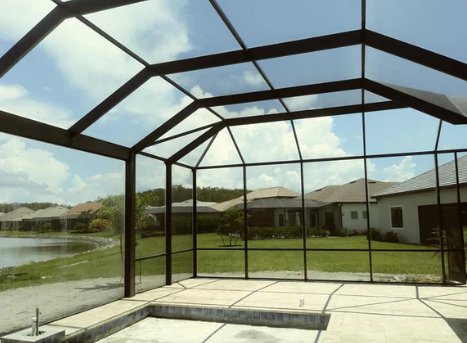
DIY Screen Rooms: A Comprehensive Guide to Building Your Perfect Outdoor Space
Shalini Gupta
Creating a DIY screen room can transform your outdoor area into a comfortable, insect-free haven where you can enjoy the beauty of nature without the nuisance of bugs. Screen rooms are versatile spaces that can serve as a cozy retreat, a dining area, or even a playroom for children. Whether you're a seasoned DIYer or a beginner, this guide will walk you through the essential steps of designing, building, and maintaining your screen room.
Why Build a Screen Room?
Before diving into the DIY aspects, let’s explore why a screen room is a great addition to your home:
- Bug Protection: Screen rooms are perfect for keeping insects like mosquitoes, flies, and bees out, allowing you to enjoy your outdoor space without being bothered.
- Weather Protection: While not fully enclosed, a screen room offers partial protection from the elements, such as light rain and sun, making it a comfortable place to relax.
- Versatility: Screen rooms can be used for various purposes, including dining, lounging, or as a play area for kids. They extend your living space and increase the usability of your outdoor area.
- Enhanced View: Enjoy the outdoors without the interruptions of pests or harsh weather conditions, while still being able to see your garden or yard.

Planning Your DIY Screen Room
1. Design and Location
Start by planning your screen room. Consider the following aspects:
- Purpose: Determine how you will use the screen room. This will influence the size and design. For example, a dining area might require more space and better ventilation than a small lounge area.
- Location: Choose a suitable location in your yard or on your porch. Ensure it’s a flat, stable area and consider accessibility, views, and sunlight exposure.
- Size: Measure the area to decide on the dimensions of your screen room. Make sure it’s large enough to accommodate your intended use while fitting well with your existing outdoor space.
- Style: Decide on the style of your screen room. Options include freestanding structures, extensions of your existing home, or even enclosures around a patio or deck.
2. Materials and Tools
For a successful DIY screen room project, gather the necessary materials and tools:
Materials
- Screening Material: Choose high-quality, durable screen material designed to withstand weather and pests. Options include fiberglass, aluminum, or stainless steel.
- Framing Material: Depending on your design, you might use wood, aluminum, or vinyl for the frame. Ensure the material is sturdy and weather-resistant.
- Fasteners and Hardware: Purchase screws, nails, and other fasteners appropriate for your framing material. You'll also need corner brackets and door hinges if applicable.
- Roofing Material: If your screen room will have a roof, consider options like corrugated panels or shingles, depending on the style and weather resistance you require.
Tools
- Measuring Tape: For accurate measurements of your space and materials.
- Saw: To cut framing material to size. A circular saw or miter saw is recommended.
- Screwdriver/Drill: For assembling the frame and attaching screens.
- Hammer: For nails and other fasteners.
- Level: To ensure your frame is straight and even.
- Stapler or Screen Tool: For attaching the screen material to the frame.
Building Your DIY Screen Room
1. Preparing the Site
- Clear the Area: Remove any debris, plants, or obstacles from the chosen location.
- Level the Ground: Ensure the ground is flat and level. You might need to add gravel or level the area using a shovel and rake.
2. Constructing the Frame
- Measure and Cut: Based on your design, measure and cut the framing materials to size.
- Assemble the Frame: Build the frame using your chosen material (wood, aluminum, or vinyl). Start with the base and work your way up. Use a level to ensure everything is straight.
- Install the Frame: Secure the frame to the ground or existing structure using appropriate fasteners. For a freestanding screen room, anchor the frame securely to prevent movement.
3. Installing the Screens
- Cut the Screen Material: Cut the screen material to fit the frame, leaving a little excess around the edges.
- Attach the Screens: Use a stapler or screen tool to attach the screen material to the frame. Start from one corner and work your way around, pulling the screen tight to avoid wrinkles.
- Secure the Edges: Trim any excess screen material and secure the edges with additional staples or screen clips.
4. Adding Doors and Roof
- Install Doors: If your screen room includes a door, install it according to the manufacturer’s instructions. Ensure it opens and closes smoothly.
- Add Roofing: If your design includes a roof, install the roofing material as per your chosen method. Ensure it is securely attached and provides adequate coverage.
5. Finishing Touches
- Seal Gaps: Check for any gaps or openings around the screen room and seal them to prevent insects from entering.
- Paint or Stain: If using wood, consider painting or staining the frame to protect it from the elements and enhance its appearance.
- Furnish and Decorate: Add furniture, rugs, or other decorations to make the space inviting and functional. Choose outdoor furniture that can withstand weather conditions.
Maintaining Your DIY Screen Room
To ensure your screen room remains in good condition, follow these maintenance tips:
1. Regular Cleaning
- Clean the Screens: Dust and debris can accumulate on screens, so regularly clean them with a mild soap solution and a soft brush. Rinse thoroughly with water and let them air dry.
- Inspect the Frame: Check the frame for any signs of wear, rust, or damage. Repair or replace any damaged parts as needed.
2. Seasonal Care
- Winterize the Screen Room: If you live in an area with harsh winters, consider removing or covering the screens during the off-season to prevent damage from snow and ice.
- Check for Pests: During warmer months, inspect for any signs of pests that might have entered through gaps or damaged screens.
3. Repair and Replacing
- Fix Tears or Holes: If the screen material gets torn or damaged, repair it promptly. You can use screen repair patches or replace the affected section of the screen.
- Replace Damaged Parts: Replace any damaged framing, roofing, or hardware to maintain the integrity and functionality of your screen room.
Conclusion
Building a DIY screen room is a rewarding project that adds functionality and enjoyment to your outdoor space. By following this comprehensive guide, you can create a comfortable, bug-free area that enhances your home’s living space. From planning and constructing to maintaining your screen room, each step is crucial for ensuring a successful and long-lasting addition to your home.
For more resources and products related to screen rooms, visit myubi.net. Happy building!



